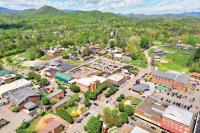When the Park becomes a classroom: From real life science to a trip back in time, the Smokies provides fertile ground for learning
While most national parks serve as conduits for science, the Smokies is a window on history as well. Churches, schools, general stores, lumber camps, grist mills, farms and homes once filled the valleys and hollers that now constitute the Great Smoky Mountains National Park.
A program called Parks as Classrooms takes students back to those early days before the park was here, using the backdrop of the recreated farmstead of the Mountain Farm Museum and Mingus Mill, both near the park’s North Carolina entrance outside Cherokee. Their tour guide is often Jay Johnstone, a fun-loving park ranger who’s perfected the art of seeing the park through kids’ eyes.
“The main goal we’re trying to do is connect the kids to the past,” Johnstone said. “Connecting kids with history can be a challenge. History can be a very dull textbook.”
But in the Smokies, where culture and history have been preserved in buildings and artifacts, it comes to life, whether it’s through the clang of the blacksmith’s hammer or creaky floorboards of the old mill.
“Walking in the footsteps, that connects you,” Johnstone said. “It’s not a picture. It’s not two-dimensional. You’re immersed in it. You can’t help but imagine what life would have been like. How would my life be different? How would it be the same?”
Johnstone, who is raising three kids of his own in Waynesville, knows just how to get through to them. As the students play hot potato with a bean bag of corn kernels and thread buttons on strings to make whirly-wigs, he asks them to think about their toys today compared to back then.
Related Items
“We live in an age where more is better. Christmas isn’t good unless presents are piled to the ceiling,” Johnstone tells the kids.
The kids are particularly taken with an old black-and-white photo of students gathered on the steps of a one-room clapboard schoolhouse from the days before the Smokies became a national park. They press closer to Johnstone, awed by the faces of children their own age, staring back at them from another time but not another place, from right here where they stand today — only a century ago.
The students imagined a school where water was fetched in pails, where older boys chopped wood to feed the stove, where school only lasted six months so to not interrupt harvest and planting, and where some went to school barefoot.
Johnstone broke the spell by asking the students to whistle up their horses, the favored mode of transportation to get from one activity to the next during the field trip.
“Here they come!” Johnstone said, reaching out to grab his imaginary horse. “Now one hand on the saddle, throw your leg over and hi-yah, off we go!”
Johnstone took off down the trail with students galloping after him. When Johnstone finally stopped, breathless students encircled him to hear their next assignment: scavenger hunt through the forest in the days before supermarkets. Suddenly, birch tree twigs doubled as toothbrushes. Dried moss served as Band-aids. Sassafras roots made tea. While a novelty for today’s kids, Johnstone explained it was about necessity back then.
Students protested vehemently when asked why they couldn’t have learned all this back home in their classroom. “It is cooler to just see it for yourself,” said Cecelia Tucker, a second-grader at Clyde Elementary in Haywood County.
The fieldtrips are far from a play day. They are synched with the curriculum for each grade level, augmenting what the students are already learning that year.
Learning in action
Parks as Classrooms offers students in middle school a chance to become real scientists. Keith Roden, the principal at Waynesville Middle School, was impressed by what he saw when tagging along with a class of sixth-graders to the Applachian Highlands Science Learning Center in the Haywood County section of the Smokies last fall. As the students probed the woods for insects and put them under a microscope, they quickly fell into friendly competition over who caught the most and whose bugs were cutest.
“They are learning here just like they do in the classroom, but fieldtrips like these stick in their minds. They make an impression. It’s something they can relate to,” Roden said.
Students scrambled to take turns with the insect sucker, a long tube with a bulbous rubber tip akin to a turkey baster, while the rest sifted through leaf litter like they were panning for gold. Before long, they developed a bond with their insects, concerned whether the critters would be turned loose after the microscope session and whether the suctioning injured them.
The creepy crawlies brought the otherwise boring subject of soil to life for the students.
“You really don’t notice all the things in dirt like bugs, but when you take the time to notice them it is really cool,” said Sam Dickson, a sixth-grader at Waynesville Middle School.
The insect exercise was coupled with a battery of soil tests to measure chemical and physical attributes of the soil.
“If you take the fieldtrip the right way, you really see nature and science in a different way,” said Jacob Estrada, also a Waynesville sixth-grader. “Something that you just ignore but when you take the time to explore it, you really see it is the source of life.”
Teachers draw on the exercises in the park all year long, said Park Ranger Susan Sachs, the education coordinator for the Appalachian Highlands Science Learning Center, a park outpost at Purchase Knob near Maggie Valley.
“The teachers will say ‘Remember when we were in the park and we took pH of the soil?’” Sachs said. “It makes it real for them.”
Students get satisfaction from doing real science, not just duplicating prefab experiments out of a textbook. Whether it’s counting insects at Purchase Knob or measuring wind speed at Clingmans Dome, the students’ results are entered in an online data base. Students can compare their results to those of other classes previous years. It gives them a sense of their contribution to science. Sachs said rangers track changes in the environment based on students’ findings. Called “citizen science,” it’s one of the hallmarks of Parks as Classrooms.
“It makes it more fun and exciting when you are out there doing it,” said Tiffany Dennis. “You are out in nature, so it feels like a real scientist.”
More than 15,000 school children come face-to-face with the wonder of the park every year through Parks as Classrooms.
The Great Smoky Mountains National Park was one of the first in the nation to launch Parks as Classrooms. The idea arose in 1991, pushed by the National Park Foundation during the 75th anniversary of the National Park Service. The Smokies was selected as a pilot park and set about developing a program that was intrinsic to the Smokies but could provide a model for others.
While successful, the pressure of standardized testing in schools has made it harder for teachers to justify fieldtrips.
“A lot of people feel they need to be in the classroom to teach what is ultimately going to be tested,” said Karen Ballentine, education chief for the park.
That’s where Parks as Classrooms has an edge over other field trips, however.
“I think it helps them academically and puts things in context in terms of real world learning,” Ballentine said. “We can demonstrate to a principal that the time away from the classroom actually enhances their learning and does not detract from it.”
Fieldtrips build knowledge from one year to the next, designed with a natural progression for the lucky students who get to go each year. It also helps build a love for the park.
“As they move along they hopefully start to care about the parks and want to give back at that point,” Ballentine said.
A larger mission
While it is not fueled by a conscious ulterior motive, Parks as Classrooms is helping to cultivate that next generation of park supporters.
“Over time, the return on the investment is you end up with adults who are the community’s decision makers with that positive experience with the park in their background,” said George Ivey, former director of development for Friends of the Smokies. “The program resonates with some of our key supporters who also really value kids who understand conservation issues.”
Another fringe benefit to the park is forging a deeper bond with surrounding communities.
“For so many years the park was seen as a burden to local communities,” Ivey said. “Because it was formed out of private land, people had to sacrifice to create the park and did not always see the benefit. These education programs are one of the key ways attitudes have changed.”
Kids who venture to the park for a fieldtrip serve as an unsuspecting ambassador for the park when talking to their families at the dinner table that night.
“It opens their eyes to parks and open spaces,” Ballentine said. “Many of them bring their families back and take them to some of the sights they have seen, whether it is Purchase Knob or Deep Creek or Clingmans Dome.”
When Waynesville middle school Principal Keith Roden tagged along on a field trip to Purchase Knob last year, he picked up on an important value in Parks as Classrooms.
“It’s just good for them to get out and enjoy nature and hopefully want to protect it. A lot of them don’t have parents who take them out hiking and camping,” Roden said.
The Smokies is a conduit for engaging kids with the outdoors and healing the disconnect recently coined “nature deficit disorder.”
Park Ranger Jay Johnstone said nature deficit disorder is not as striking in rural areas as urban. Here, many kids have gardens in their yard, trees to climb and creeks within reach. Nonetheless, he is shocked by the number of kids who haven’t ventured into the Smokies before.
One take-home message rangers impart is that the park belongs to everyone. During a pop quiz at the end of Johnstone’s Mingus Mill fieldtrip, he asked “True or false: you own the Great Smoky Mountains National Park.” Their answer was a resounding “no.”
“Guess what? You’re all wrong,” Johnstone said. “This is your park. You own the Great Smoky Mountains National Park and 390 more.”









